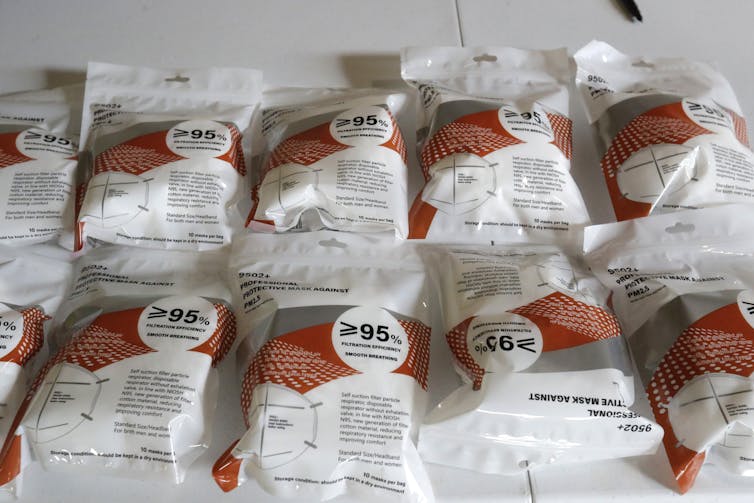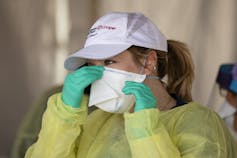CDC says masks must fit tightly – and two are better than one
- Written by Scott N. Schiffres, Assistant Professor of Mechanical Engineering, Binghamton University, State University of New York
On Feb. 10, the Centers for Disease Control and Prevention released new mask guidelines[1] based on a study of how mask fit affects the wearer’s exposure to airborne particles. With more transmissible COVID-19 strains emerging[2] around the world, it is important to properly use the right kinds of face masks[3].
Some practices – such as taking your mask off to speak or wearing your mask below your nose – are clearly problematic. Other mistakes may be less obvious. Everyone still needs to be wearing masks as much as possible – even if you’ve been vaccinated[4] or have previously been infected with COVID–19. So how do you get the most out of a mask?
 KN95 masks are good and widely available, but performance varies.
AP Photo/Wilfredo Lee[5]
KN95 masks are good and widely available, but performance varies.
AP Photo/Wilfredo Lee[5]
Mask materials
Your mask material is the most important consideration. Certain manufacturing techniques can make masks more efficient at filtering out the tiny droplets and aerosols that can carry the coronavirus.
During the past year, my graduate students and I at Binghamton University teamed up with scientists from the surgical robot company Intuitive Surgical[6] and the Intuitive Foundation to test the effectiveness of different fabrics at filtering out airborne particles. Our work has been used by the CDC to inform mask guidelines[7].
Researchers believe that an infected person who talks expels droplets that can spread COVID-19 – especially in the 2- to 5-micron range[8], about 10 times smaller than the width of a typical human hair. One reason to wear masks is to catch these relatively big particles before they dry out and shrink into smaller particles, called aerosols[9], which linger in the air longer because of their diminished size.
For example, a 3-micron saliva droplet could shrink down to about 1 micron[10]. Researchers think that droplets in the 2- to 5-micron range are most transmissive of COVID-19[11]. This range is the sweet spot for droplets to linger in the air due to their small size, while still having a high probability of containing the virus.
N95 masks are the gold standard among lightweight respirators and are at least 95% effective at filtering out particles at 0.3 microns[12], well below the average size thought to dominate COVID-19 transmission. They are typically greater than 99% effective for particles 2 to 5 microns across. When leakage around the mask seal is taken into account, the performance typically drops to 90% to 95%[13].
 A well-fitting mask won’t allow much air to leak around the seal to the face, especially around the nose, chin and facial hair.
AP Photo/Matt Rourke[14]
A well-fitting mask won’t allow much air to leak around the seal to the face, especially around the nose, chin and facial hair.
AP Photo/Matt Rourke[14]
KN95 masks, which have become more prevalent in the U.S. over the past few months, are the Chinese equivalent of N95 masks and are often the next best mask option in terms of performance. While KN95 masks often meet the N95 specifications, some researchers found their performance to be inconsistent[15] in a study that has not yet been peer reviewed. The CDC maintains a list of internationally produced masks and their filtration performance[16] that you can use to confirm the performance of masks before purchase.
Medical-procedure masks – specifically ASTM F2100-19, Class 1 masks[17], the blue papery ones you see everywhere – are typically made of several layers of meltblown nonwoven fabrics. If one had a perfect seal to your face, the material could filter out 95% of particles as small as 0.1 microns[18] across. But these masks don’t seal all that well, and when you take into account the air leakage, filtration in typical usage drops to about 80%[19].
Cotton masks are among the most commonly worn and can also provide decent filtration. The filtration varies according to the tightness of the weave, and one study found that two layers of various widely available cotton fabrics filtered out between 34% and 66% of particles[20] in the 2- to 5-micron range. This is good for catching particles from a person talking, but it won’t block small aerosols in the environment.
In our research, we tested a wide range of fabrics to see which worked best. Some samples were washed as many as 10 times with a variety of detergents and then retested for effectiveness. In our study[21], which is currently under peer review, we found the best combination was soft flannel on the inside for comfort, thin-as-possible cotton on the outside and an efficient filter in the middle.
Two masks are good, but make sure they fit
No matter how good a mask’s material is, it won’t work well if it doesn’t fit well. A lot of filtration efficiency is lost from leakage around the face mask, such as around the bridge of the nose or at the gaps between any facial hair and the mask. A well-fitting mask is one that seals tightly onto your face, ensuring that almost all the air you breathe goes through the filtering material rather than through gaps in the sides.
The CDC’s new guidelines are based on a study that tested ways to improve how masks fit[22] – specifically double-masking and what they call “knotting and tucking.”
Double-masking is wearing a cotton mask over a medical-procedure mask. Knotting and tucking entails tying a knot in the elastic loops that go over your ears, close to where they attach to the mask. Then, you tuck the extra mask fabric into the gap that is often present where the ear loops attach to the mask, and flatten that part as much as possible. Both of these tricks to make a better fit decrease the mask-wearers’ exposure to potentially infectious aerosols by 95%[23] as compared with wearing no mask at all. That’s a 15% improvement over the 80% efficiency[24] found when using a single surgical mask.
 Gaps on the sides of single surgical masks (a) can be reduced by (b) using a lightweight cotton mask to create a closer fit to the face or (c) knotting and tucking.
CDC[25]
Gaps on the sides of single surgical masks (a) can be reduced by (b) using a lightweight cotton mask to create a closer fit to the face or (c) knotting and tucking.
CDC[25]
DIY fit test
To get the best fit when using a mask, bend the metal nosepiece so that the mask tightly fits the curve of your nose. It is also important to make sure your mask fits beneath your chin and to remove any facial hair – air will take the path of least resistance through stubble rather than through the fine fibers of the mask.
Some places, such as hospitals and labs, do mask fit tests that are certified by the Occupational Safety and Health Administration. But these are impractical for home use. You can do your own qualitative fit test at home by lighting a citronella or other oil-scented candle[26] and trying to smell it with and without a mask. The aerosols from a citronella candle are 0.01 to 0.02 microns across[27] – much smaller than typical droplets from humans that would contain COVID-19. If you can’t smell the candle, or the smell is significantly reduced, you’re likely wearing your mask correctly.
Keep in mind, however, that this test is far from exact. For instance, cotton masks won’t filter out these tiny candle aerosols, but are still an important tool to block the majority of coronavirus droplets.
Making sure you are getting the most out of your masks is critical to slowing this pandemic. Double-masking or knotting and tucking, as well as using the right materials, can ensure that you and those around you are safer.
[Get our best science, health and technology stories. Sign up for The Conversation’s science newsletter[28].]
References
- ^ new mask guidelines (www.cdc.gov)
- ^ more transmissible COVID-19 strains emerging (doi.org)
- ^ right kinds of face masks (doi.org)
- ^ even if you’ve been vaccinated (www.npr.org)
- ^ AP Photo/Wilfredo Lee (newsroom.ap.org)
- ^ Intuitive Surgical (www.intuitive.com)
- ^ used by the CDC to inform mask guidelines (www.cdc.gov)
- ^ 2- to 5-micron range (doi.org)
- ^ smaller particles, called aerosols (theconversation.com)
- ^ shrink down to about 1 micron (doi.org)
- ^ are most transmissive of COVID-19 (doi.org)
- ^ particles at 0.3 microns (www.ncbi.nlm.nih.gov)
- ^ the performance typically drops to 90% to 95% (www.ncbi.nlm.nih.gov)
- ^ AP Photo/Matt Rourke (newsroom.ap.org)
- ^ performance to be inconsistent (doi.org)
- ^ internationally produced masks and their filtration performance (www.cdc.gov)
- ^ ASTM F2100-19, Class 1 masks (www.astm.org)
- ^ 95% of particles as small as 0.1 microns (doi.org)
- ^ filtration in typical usage drops to about 80% (doi.org)
- ^ 34% and 66% of particles (doi.org)
- ^ our study (doi.org)
- ^ study that tested ways to improve how masks fit (www.cdc.gov)
- ^ exposure to potentially infectious aerosols by 95% (www.cdc.gov)
- ^ 80% efficiency (doi.org)
- ^ CDC (www.cdc.gov)
- ^ a citronella or other oil-scented candle (doi.org)
- ^ citronella candle are 0.01 to 0.02 microns across (doi.org)
- ^ Sign up for The Conversation’s science newsletter (theconversation.com)
Authors: Scott N. Schiffres, Assistant Professor of Mechanical Engineering, Binghamton University, State University of New York
Read more https://theconversation.com/cdc-says-masks-must-fit-tightly-and-two-are-better-than-one-153778

